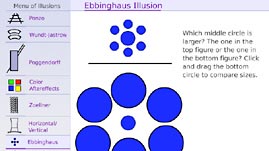Teachers' Domain - Digital Media for the Classroom and Professional Development
User: Preview

Source: Eric H. Chudler, Ph.D., Neuroscience for Kids, University of Washington
This collection of visual illusions adapted from the University of Washington's Neuroscience for Kids Web site shows that, although we can trust our senses most of the time, our minds sometimes misinterpret the visual information our eyes receive.
Humans and other sighted animals rely heavily on their sense of sight to make their way in the world. Our eyes enable us to run, jump, find food, and otherwise move around, hopefully without incident, in an environment filled with potential dangers. In fact, our eyes perform reliably so much of the time that optical illusions of any kind tend to puzzle us, whether they are distortions of size, shape, direction, motion, or perspective. Most people, especially children, assume that illusions are the result of sophisticated trickery, rather than simple misperception.
The eye is responsible for gathering visual information from an infinitely complex world. The three-dimensional environment of moving images, colors, and variations in perspective poses a daunting challenge for our visual system. As complex as this task is, the eye collects visual information in a strikingly simple way. Light reflected off of objects enters the eye and stimulates cells on the two-dimensional surface of the retina. These cells then send electrical signals to the brain in patterns that reflect the intensity, placement, and timing of the light received. It is the role of the brain to create images from these signals based on past experiences.
Although optical illusions sometimes result from slight imperfections in parts of the eye, especially the retina, it is more likely that the brain has misinterpreted visual signals. The interpretation of an infinite variety of visual information is an exceedingly complex process—so complex, according to vision experts, that the brain could not possibly rely on a single formula for processing such varied information. Instead, it is thought that the brain creates a number of possible scenarios based on signals from the eyes, and then chooses the most probable of these possibilities based on past experience. Given this explanation, optical illusions occur when the chosen interpretation—the one that we "see"—differs from the objects and light patterns that actually exist in the real world.
 Loading Standards
Loading Standards Teachers' Domain is proud to be a Pathways portal to the National Science Digital Library.
Teachers' Domain is proud to be a Pathways portal to the National Science Digital Library.
